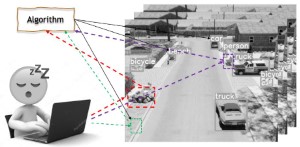
Human-in-the-Loop Extension to Stream Classification for Labeling of Low Altitude Drone Imagery
Proc. SPIE 11748, Autonomous Systems: Sensors, Processing, and Security for Vehicles and Infrastructure, 2021

Abstract
In general, there is a severe demand for, and shortage of, large accurately labeled datasets to train supervised machine learning (ML) algorithms for domains like smart cars and unmanned aerial systems (UAS). This impacts a number of real-world problems from standing up ML on niche domains to ML performance in/across different environments. Herein, we consider the task of efficiently, meaning requiring the least amount of human intervention possible, converting large UAS data collections over a shared geospatial area into accurately labeled training data. Herein, we take a human-in-the-loop (HITL) approach that is based on coupling active learning and self-supervised learning to efficiently label low altitude UAS imagery for the goal of training ML algorithms for underlying tasks like detection, localization, and tracking. Specifically, we propose an extension to our stream classification algorithm StreamSoNG based on human intervention. We also extend StreamSoNG to rely on a second and initially more mature, but assumed incomplete, ML classifier. Herein, we use the Unreal Engine to simulate realistic ray-traced low altitude UAS data and facilitate algorithmic performance analysis in a controlled fashion. While our results are preliminary, they suggest that this approach is a good trade off between not overloading a human operator and circumventing fundamental stream classification algorithm limitations.
Media